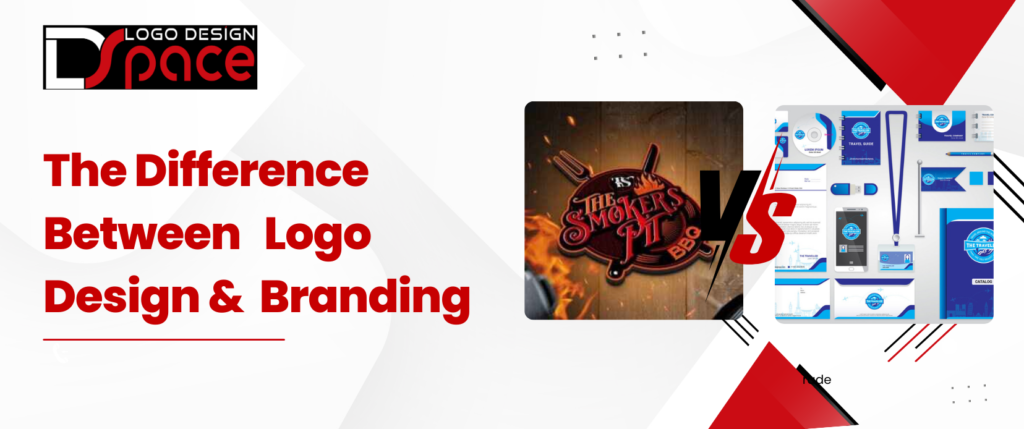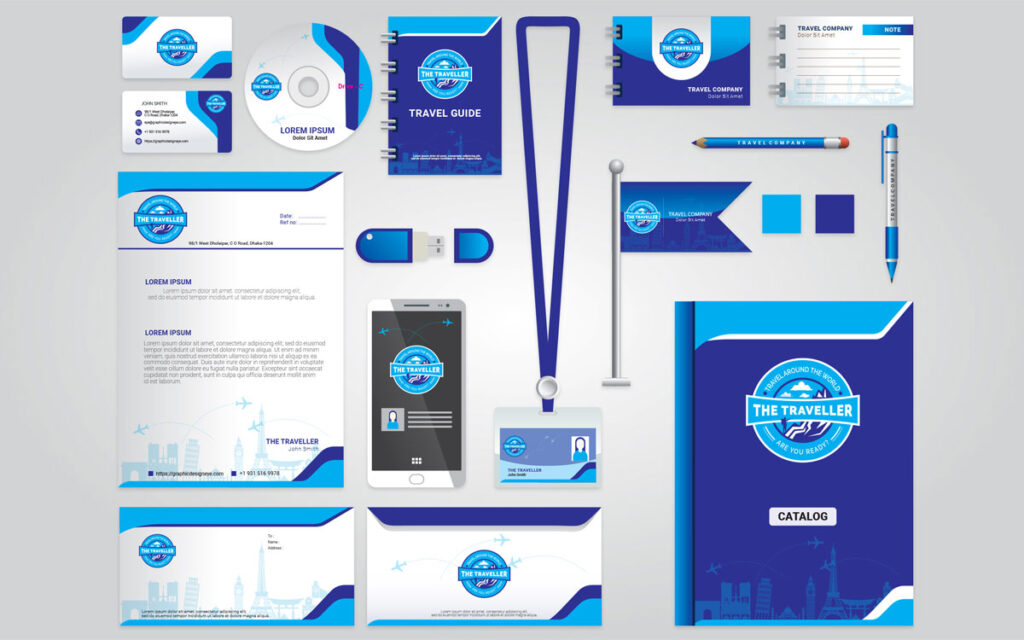- Our Services
Brand Identity
Website Design
Print Media
Brand Identity
Website Design
Print Media
Packaging Design
- Pricing
Brand Identity
Website Design
Print Media
Brand Identity
Website Design
Print Media
Packaging Design
- Portfolio
- About Us
- Our Team
- Our Reviews
- Blogs
The Difference Between Logo Design & Branding

A logo is the face of your business. It’s often the first thing potential customers notice, and it plays a crucial role in establishing brand identity. However, even the most iconic logos need a refresh from time to time. If you’re wondering when to consider rebranding your logo, you’re not alone. A well-timed logo redesign can breathe new life into your business, but how do you know when it’s time to make a change?
In this blog, we’ll explore seven essential tips to help you decide when to rebrand your logo and how to make your redesign a success.
What is Logo Design?

Logo design is the process of crafting an engaging symbol or design that plays a vital role in brand’s recognition. This symbol becomes the face of your brand, serving as a quick identifier that people can associate with your products or services. A logo often includes a combination of text and imagery—think of Nike’s swoosh or McDonald’s golden arches. These designs are simple, memorable, and instantly recognizable.
Purpose of a Logo: A logo acts as the cornerstone of your visual identity. Its primary function is to help customers easily recognize your brand in a crowded marketplace. Think of your logo as the first handshake—it introduces your business to potential customers and leaves an immediate impression.
Logo Design Elements: A strong logo combines imagery, typography, and color in a way that aligns with your brand’s identity. For example, Google’s logo uses a vibrant color palette to reflect creativity and innovation, while the clean font suggests simplicity and accessibility.
Why Logos Matter: While a logo alone doesn’t define your entire brand, it plays a significant role in building recognition. If your logo is visually appealing and distinctive, it can leave a lasting impression, setting you apart from competitors. However, it’s essential to remember that a logo is only one part of the branding equation.
What is Branding?

Branding is the overall perception people have of your business. It’s the sum of all the interactions and experiences your customers have with your company. Branding goes beyond the visual—it includes your messaging, your customer service, your company values, and how your business makes people feel.
Think of branding as your company’s personality. While a logo represents your company visually, branding defines the emotions and associations customers form over time.
Purpose of Branding: The goal of branding is to create a cohesive, memorable experience for your customers. Through consistent messaging, tone, visuals, and customer interactions, branding helps build trust and loyalty. It shapes how people think and feel about your company, influencing their decisions to buy from you.
Elements of Branding: Branding includes everything from your company’s mission and core values to your tone of voice, visual identity, and customer service style. A strong brand should be recognizable not only by its logo but also by its consistent messaging and the emotions it evokes.
For instance, Apple is known not just for its sleek products and iconic logo, but for its emphasis on innovation, simplicity, and premium quality. Every aspect of Apple’s branding—from their minimalist stores to their ad campaigns—reinforces these values.
Why Branding Matters: Branding builds an emotional connection between your business and your customers. People are more likely to trust and return to brands that they feel align with their values or solve their problems. A strong brand can also command higher prices and create a loyal customer base that becomes your biggest advocates.
Key Differences Between Logo Design and Branding
Although logo design and branding are related, they have distinct roles:
Function:
Logo Design: A logo is a visual marker that helps people identify your business. It’s the first thing they notice when they see your products, ads, or website.
Branding: Branding encompasses the overall customer experience. It’s how people feel when they interact with your company, including their perceptions, emotions, and expectations.
Scope:
Logo Design: The design of a logo focuses on visual representation, using colors, fonts, and shapes to create a unique symbol.
Branding: Branding is a long-term strategy that covers everything from how you answer the phone to how your products are packaged. It establishes the values and principles of your Brand.
Impact:
Logo Design: A logo provides instant recognition. Customers may see it on your website, social media, or storefront and know who you are.
Branding: Branding is what builds loyalty and trust over time. It shapes your relationship with your audience and fosters long-term engagement.
Why Both Logo Design and Branding Are Essential for Business Success
Some business owners might think they can get by with just a logo, but this approach is short-sighted .Your logo is just the beginning. . Here’s why you need both:
1. Logos Spark Recognition, Branding Builds Trust
A memorable logo is the first step toward brand recognition. For example, when you see Starbucks’ green mermaid logo, you immediately think of coffee. But what keeps you coming back to Starbucks is more than the logo—it’s the consistent experience you have, whether it’s the friendly service, the ambiance, or the product quality. That’s branding at work.
2. Branding Adds Meaning to Your Logo
Without branding, a logo is just an image. A well-branded business gives that image meaning and context. For instance, Tesla’s sleek logo represents more than just cars—it stands for innovation, sustainability, and futuristic technology. That association comes from Tesla’s branding efforts, not just the logo itself.
3. Consistency Is Key
Branding ensures that all aspects of your business—from your logo to your website and marketing materials—are consistent. Over time, credibility and trust are increased by this consistency. When customers have a seamless experience across all touchpoints, they’re more likely to feel comfortable choosing your brand.
Practical Examples of Logo Design and Branding in Action
Here are a few examples to help illustrate the differences between logo design and branding:
Nike: The Nike swoosh logo is a striking visual emblem that is instantly recognizable. But Nike’s branding goes beyond that. Its consistent message of empowerment, achievement, and athletic excellence is what solidifies its brand identity.
Coca-Cola: The logo has remained largely unchanged for over a century, but Coca-Cola’s branding has evolved. The brand consistently conveys messages of happiness, joy, and togetherness through its advertising, packaging, and even product placement.
Airbnb: Their logo—a simple, symbolic “A”—is minimalistic. However, Airbnb’s branding speaks to a sense of belonging, community, and personalized travel experiences. Their website, customer service, and social media presence all support this theme, creating a brand that resonates emotionally with users.
How to Combine Logo Design and Branding Effectively
To create a successful brand, it’s important to seamlessly integrate your logo with your overall branding strategy. Here’s how to do it:
Know Your Audience: Before designing a logo, make sure you fully understand your target audience. What appeals to them? What emotions do you want to evoke? This knowledge will guide your logo design and branding efforts.
Consistency is Key: Use your logo consistently across all platforms—your website, social media, packaging, and marketing materials. Ensure that everything else (colors, tone of voice, imagery) aligns with your brand’s identity.
Create a Brand Story: A brand is more than just a logo and a product. Tell a story about why your business exists, what you believe in, and what makes you unique. This story should be reflected in all aspects of your branding.
Don’t Be Afraid to Evolve: While consistency is important, brands need to evolve with the times. Sometimes that means refreshing your logo or tweaking your messaging to stay relevant. Pepsi, for example, has updated its logo multiple times to stay current while still maintaining its core brand identity.
Conclusion
Both logo design and branding are essential for business success. While your logo provides a recognizable face for your business, branding shapes the way people feel about your company. A well-designed logo will grab attention, but consistent and meaningful branding will build lasting relationships with your customers.
By understanding and leveraging the differences between logo design and branding, you can create a cohesive, engaging, and memorable identity that sets your business apart from the competition. Whether you’re a startup or an established company, investing in both your logo and branding is key to long-term success.

